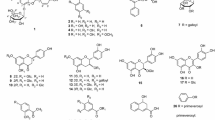Abstract
In a bioassay-guided search for anti-allergic compounds from higher plants of Korea, polymethoxyflavones, 3′,4′,5,6,7,8-hexamethoxyflavone (I), 5-hydroxy-3′,4′,6,7,8-pentamethoxyflavone (II) and 3′,4′,5,7,8,-pentamethoxyflavone (III) have been isolated from the immature peels ofCitrus unshiu. Structures of these compounds were elucidated on the basis of spectroscopic techniques. CompoundsI andII inhibited dose-dependently histamine release from the rat peritoneal mast cells activated by compound 48/80 or anti-DNP IgE.
Similar content being viewed by others
References Cited
Bueb, J. L., Mousli, M. C., Bronner, C., Rouot, B. and Landry, Y., Activation of Gi-like proteins; a receptor-independent effect of kinins in mast cells.Mol. Pharmac., 38, 816–822 (1990).
Chun, Y. T. and Sankawa, U., Screening of anti-allergic effect in traditional medicinal drugs and active constituents of Auratii Fructus Immatrus.Shoyakugaku Zasshi, 43, 314–323 (1989).
Iinuma, M., Matsuura, S. and Kusuda, K.,13C-Nuclear magnetic resonance (NMR) spectral studies on poly-substituted flavonoids. I.13C-NMR Spectra of Flavones.Chem. Pharm. Bull., 28, 708–716 (1980a).
Iinuma, M., Matsuura, S. Kurogochi, K. and Tanaka, T., Studies on the constituents of useful plants.Chem. Pharm. Bull., 28, 717–722 (1980b).
Kanemoto, T. J., Kasugai, T., Yamatodani, A., Ushio, H., Mochizuki, T., Tohya, K., Kimura, M., Nishimura, M., and Kitamura, Y., Supernormal histamine release and normal cytotoxic activity of Biege rat mast cells with giant granules.Inter. Arch. of Allergy and Immunol., 100, 99–106 (1993).
Machida, K. and Osawa, K., On the flavonoid constituents from the peels ofCitrus hassaku Hort.ex Tanaka.Chem. Pharm. Bull., 37, 1092–1094 (1989).
Mizuo, M. Yoshinobu M., Toshiyuki, T., Hiroko, T. and Munekazu, I., Two new flavones inCitrus reticulata.J. of Nat. Prod., 50, 751–753 (1987).
Namba, T., The encyclopedia of Wakan-Yaku with color pictures Vol. I: Hoikuha, Osaka, 257–260 (1993).
Shore, P. A., Burkhalter, A. and Cohn, V. H., A method for fluorometric assay of histamine in tissues.J. Pharmacol. Exp. Ther., 127, 182–186 (1959).
Yurt, R. W., Leid, R. W. and Austen, K. F., Native heparin from rat peritoneal mast cells.J. Biol. Chem., 252, 518–521 (1977).
Author information
Authors and Affiliations
Corresponding author
Rights and permissions
About this article
Cite this article
Kim, D.K., Lee, K.T., Eun, J.S. et al. Anti-allergic components from the peels ofCitrus unshiu . Arch Pharm Res 22, 642–645 (1999). https://doi.org/10.1007/BF02975340
Received:
Issue Date:
DOI: https://doi.org/10.1007/BF02975340




